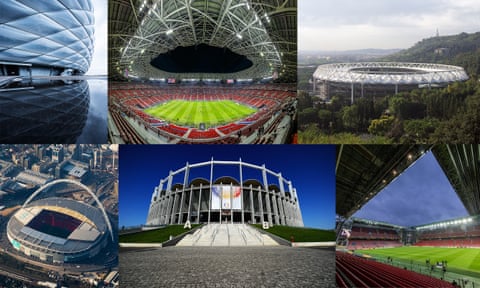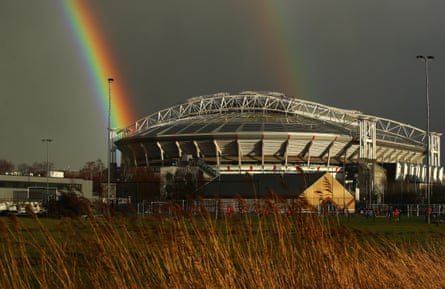
Johan Cruyff Arena, Amsterdam
Opened: 1996
Capacity: 54,000
Expected attendance: 12,000
Euro 2020 fixtures:
Netherlands v Ukraine, 13 June
Netherlands v Austria, 17 June
North Macedonia v Netherlands, 21 June
Round of 16, 26 June
Formerly known as the Amsterdam ArenA, the home of Ajax was renamed in 2018 in honour of the late Johan Cruyff, who had died two years previously. Built as a replacement for the storied Dutch club’s previous home, De Meer, once it became too small for purpose, it was the first football stadium in Europe to boast a retractable roof. Its inauguration in August 1996 was marked by a game between Ajax and Milan, with the Italian side’s midfielder Dejan Savicevic scoring the first goal there.
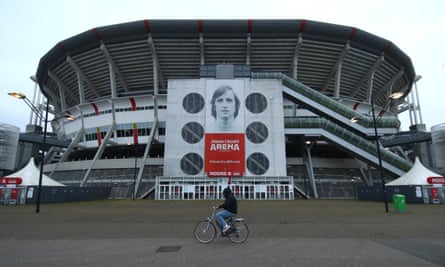
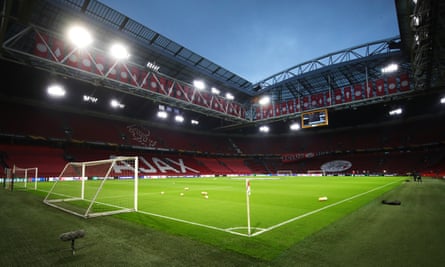
The Johan Cruyff ArenA hosted the 1998 Champions League final between Real Madrid and Juventus and the 2013 Europa League final between Chelsea and Benfica, plus several group and knockout matches at Euro 2000. In recent years it has undergone renovations which began in 2016, including the replacement of 5,000 seats with a “safe-standing” area which cannot be used in Uefa-governed tournaments.
The plush stadium prides itself on being one of the five most sustainable sports venues on the planet and boasts 4,200 solar panels, its own dedicated wind farm and a rainwater harvesting system for pitch irrigation.
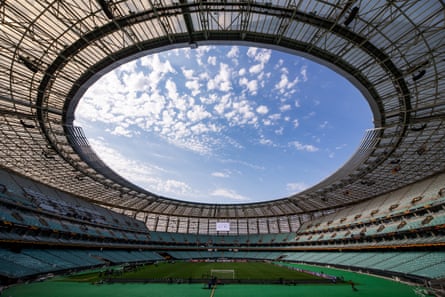
Baku Olympic Stadium
Opened: 2015
Capacity: 69,000
Expected attendance: 31,000
Euro 2020 fixtures:
Wales v Switzerland, 12 June
Turkey v Wales, 16 June
Switzerland v Turkey, 20 June
Quarter-final, 3 July
The home of Azerbaijan’s national football team, the Baku Olympic Stadium was built at a cost of $600m on the shore of Lake Boyukshor on the former Soviet republic’s Absheron Peninsula. It opened in 2015, when it hosted the inaugural edition of the European Games. Four years previously, the foundation had been laid at a ceremony attended by the then Fifa and Uefa presidents, Sepp Blatter and Michel Platini, who have since been forced out of their respective offices in disgrace.
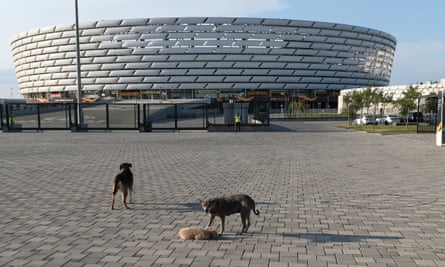
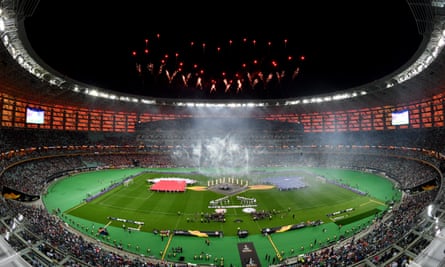
Commissioned by an Azerbaijan government whose attitude to human rights is famously questionable, the stadium is widely viewed as a vanity project undertaken to help them buy the respect of other European nations through the medium of “sportswashing”, specifically the hosting of prestigious events. It is a policy that appears to be bearing fruit, although the decision to award the 2019 Europa League final to Baku came drenched in controversy. Arsenal’s Armenian midfielder Henrikh Mkhitaryan elected not to travel to the showdown with Chelsea out of concerns for his safety, while some British-Armenian fans claimed to have been denied visas.
According to the architecture and design publication CLADmag, the stadium’s “form was inspired by the ribbons of rhythmic gymnasts and strobe lighting is used to make the building look as though it’s fluttering”.
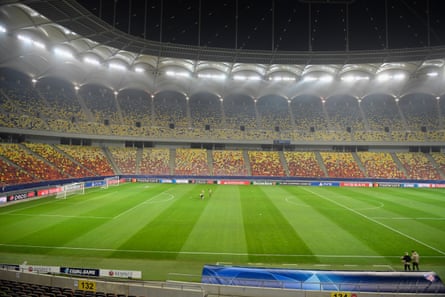
National Arena, Bucharest
Opened: 2011
Capacity: 54,000
Expected attendance: 13,000
Euro 2020 fixtures:
Austria v North Macedonia, 13 June
Ukraine v North Macedonia, 17 June
Ukraine v Austria, 21 June
Round of 16, 28 June
Built at a cost of $260m in the eastern suburbs of the Romanian capital on the site of its predecessor, the Lia Manoliu, the palatial National Arena is owned by the city municipality and is home to Steaua Bucharest, their bitter rivals Dinamo and the Romania national team. A year after opening, it hosted the all-Spanish 2012 Europa League final between Atlético Madrid and Athletic Bilbao.


Following its inauguration with a Euro 2012 qualifier between Romania and France, the state of the pitch was widely condemned and “the world’s leading sports surface solutions provider”, STRI, were tasked with temporarily relaying the surface before undertaking a complete reconstruction. “The pitch performance during the Romania versus France match was of great embarrassment to the Romanian authorities,” said Paul Flanagan, who oversaw the project.
Designed in the style of an ancient colosseum with eyecatchingly steep sides – the steepest permissible under European law – the National Arena has two underground and three upper levels with subterranean parking spaces for 2,100 vehicles. The upper levels boast 42 VIP skyboxes, a lounge, restaurants, restrooms and concession areas. The stadium also features state-of-the-art sound and video systems and the all-important retractable roof.
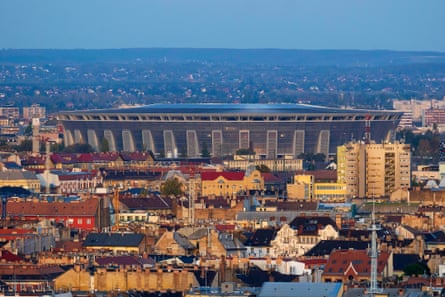
Puskas Arena, Budapest
Opened: 2019
Capacity: 68,000
Expected attendance: 61,000
Euro 2020 fixtures:
Hungary v Portugal, 15 June
Hungary v France, 19 June
Portugal v France, 23 June
Round of 16, 27 June
Located just a 10-minute walk from Budapest Keleti central station, the Puskas Arena is the largest stadium in the Hungarian capital and hosts the national team, who will hope to reap the benefits of playing group games against Portugal and France in the only venue operating anywhere near full capacity during Euro 2020.
Built on the site of the old Ferenc Puskas Stadium, the scene of England’s heaviest defeat (a 7-1 thrashing in May 1954, in which the Hungarian legend from whom the stadium is named scored two goals), the ground hosted the 2020 UEFA Super Cup between Bayern Munich and Sevilla and was more recently pressed into service as a replacement venue for various Champions League matches.


The brainchild of architect Gyorgy Skardelli, it was designed with the preservation of its predecessor’s character in mind and retains its old brick walls as its main entrance. Its oval shape and decorated towers were also inspired by the arena it was built to replace.
“The construction of the new Puskas Arena stadium puts together the architectural values of the old stadium along with the implementation of the most modern techniques,” say Codina Architectural, the firm responsible for designing and installing its striking mesh metal skin, which covers a total surface area of 19,500 square metres.
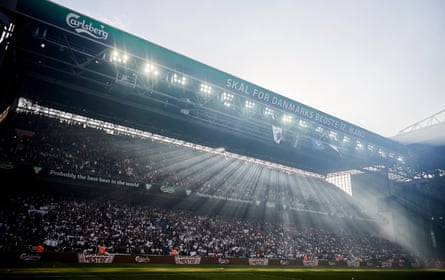
Parken Stadium, Copenhagen
Opened: 1992
Capacity: 38,000
Expected attendance: 11,250
Euro 2020 fixtures:
Denmark v Finland, 12 June
Denmark v Belgium, 17 June
Russia v Denmark, 21 June
Round of 16, 28 June
Built on the site of Idraetspark, Denmark’s previous national stadium in the Indre Østerbro district, the Parken Stadium is the largest football ground in Denmark and home to FC Copenhagen and the Danish national team. Refurbished with a view to staging concerts as well as football matches, it has a retractable lower seating tier at one end to facilitate a stage. Its record attendance remains the 60,000 who turned up for a Michael Jackson gig in 1997.
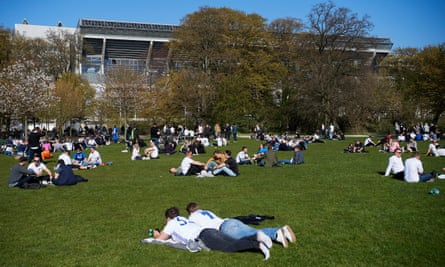
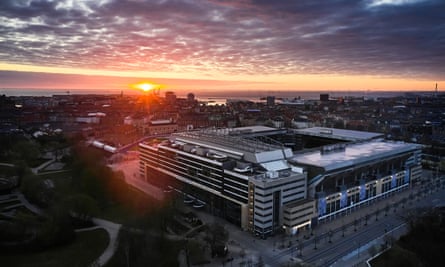
It also has a retractable roof, which was installed ahead of the 2001 Eurovision song contest, making the Parken Stadium the biggest venue ever to host the competition. The owners withdrew their bid to stage it a second time in 2014, upon realising the disruption it would have caused to FC Copenhagen’s fixture schedule.
Travelling Arsenal fans of a certain age will be well-acquainted with this imposing ground, as it hosted the 1994 Uefa Cup Winners Cup final in which Alan Smith volleyed George Graham’s side to victory over Parma. Six years later, an Arsenal side managed by Arséne Wenger returned to the Parken for the final of the Uefa Cup, losing on penalties to Galatasaray. It will host four matches at Euro 2020 and will operate at approximately 33% capacity.

Hampden Park, Glasgow
Opened: 1903
Capacity: 51,000
Expected attendance: 12,000
Euro 2020 fixtures:
Scotland v Czech Republic, 14 June
Croatia v Czech Republic, 18 June
Croatia v Scotland, 22 June
Round of 16, 29 June
The oldest international football stadium in the world, Hampden Park welcomed what was at the time a world record attendance of 149,415 fans through its doors for Scotland’s 3-1 win over England in April 1937. Its official capacity has since diminished considerably and will be further reduced to 12,000 fans for Euro 2020.
Owned by the Scottish Football Association, who completed their £5.1m purchase of the ground from Scottish League Two side Queen’s Park in 2019 after protracted wrangling, Hampden has hosted six European club finals, including that of the 1960 European Cup, when Real Madrid beat Eintracht Frankfurt 7-3 in arguably the greatest decider of them all.


Visitors are often critical of the poor sightlines and facilities at the home of Scottish football despite its £50m refurbishment in the 1990s. The east and west stands are widely accepted to be too far from the pitch and plans to move them closer have been mooted. The former Scotland international Scott Brown has been vocal in his criticism of Hampden and criticised the SFA’s decision to keep it as the home of Scottish football in 2018. “Hampden is possibly one of the worst stadiums I have played in for atmosphere,” he said, going on to suggest Scotland’s highest profile games should be rotated between Celtic Park and Ibrox.

Wembley, London
Opened: 2007
Capacity: 87,000
Expected attendance: 22,500 (for group games and R16, semi-finals and final to be confirmed)
Euro 2020 fixtures:
England v Croatia, 13 June
England v Scotland, 18 June
Czech Republic v England, 22 June
Round of 16, 26 and 29 June
Semi-finals, 6 and 7 July
Final, 11 July
Finally opened to the public on 9 March 2007 after almost a decade of delays, spiralling costs and legal disputes, Wembley Stadium was rebuilt for an incredible final price tag of over £800m and signalled the end of the England team’s popular experiment of playing their home internationals in various grounds around the country during their period of enforced homelessness.
Multiplex, the Australian construction firm who were contracted to build the stadium famously lost almost £150m on the project and revelations that their onsite labourers had queued up at the local branch of a well-known bookmaker to bet against the job being finished in time for the 2006 FA Cup final spoke volumes about the fiasco.
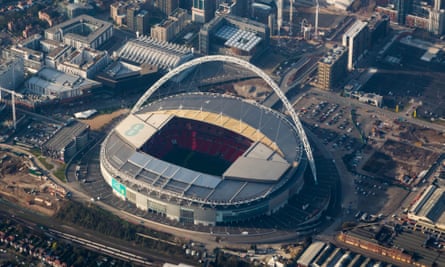

They got there in the end, however and the results are undeniably impressive. The 87,000-capacity bowl boasts the longest single roof span in the world in the 135-metre high Wembley arch, which curves 315 metres over the stadium and supports the ceilings of the north and south stands.
The seats are more steeply banked than in Wembley’s previous incarnation and are laid out in three tiers, ensuring that while the action on the pitch might not always be of the highest standard, there is no such thing as a bad view.
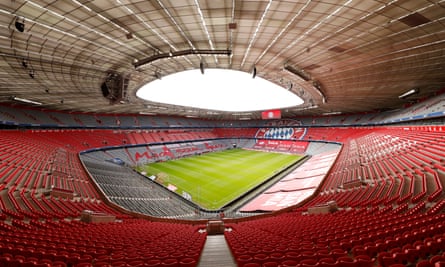
Football Arena Munich
Opened: 2005
Capacity: 70,000
Expected attendance: 14,500
Euro 2020 fixtures:
France v Germany, 15 June
Portugal v Germany, 19 June
Germany v Hungary, 23 June
Quarter-final, 2 July
With its translucent exterior that can be lit up in a variety of different colours – up to 16 million of them, if Uefa’s official website is to be believed – by 4,000 specially developed lights, the ground Bayern Munich call home is among Europe’s more visually arresting stadiums, even if it does at times resemble a giant rubber dinghy. Its designers, the Swiss architects Jacques Herzog and Pierre de Meuron, describe it as “a milestone in their company’s development” and take pride in the fact it took just 30 months to build from scratch.


Originally commissioned by Bayern and 1860 Munich in a joint venture, the less successful of the two clubs was forced to sell their interest in the stadium to their rivals for €11m in 2006 out of financial necessity. They continued to play their home games there as paying tenants until Bayern cancelled the arrangement in 2017 after 1860 Munich dropped to the fourth division.
Built with reinforced concrete and covered with a roof made from steel latticework, the entire building is wrapped in diamond-shaped air cushions which are generally illuminated in the team colours of whoever is playing there. Germany, Hungary, France and Portugal, among other nations, will get their own bespoke light shows this summer.

Olimpico in Rome
Opened: 1953
Capacity: 68,000
Expected attendance: 16,000
Euro 2020 fixtures:
Turkey v Italy, 11 June
Italy v Switzerland, 16 June
Italy v Wales, 20 June
Quarter-final, 3 July
The centrepiece of the Foro Italico sports complex north of Rome, the construction of the Stadio Olimpico began in 1928 but was interrupted by the outbreak of the second world war and did not resume until 1950. Largely terraced until 53,000 seats were installed in preparation for the 1960 Olympics, it went on to host games at the 1968 and 1980 European Championships before undergoing major renovations for the 1990 World Cup.
Annibale Vitellozzi, the stadium’s original architect, was part of the team of designers entrusted with the redesign, the plans for which were repeatedly torn up and redrawn as costs skyrocketed. The stadium was eventually demolished and rebuilt with the pitch much closer to stands which had an increased capacity of just under 83,000.
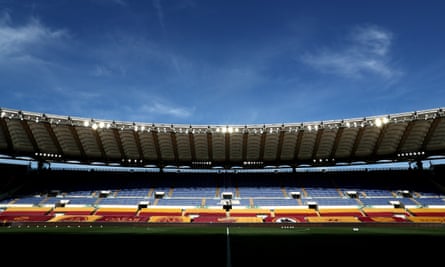

In 2007 the Stadio Olimpico underwent further refurbishment in order to conform to Uefa standards for the 2009 Champions League final between Barcelona and Manchester United. The work was largely cosmetic and involved improvements to the dressing rooms, media facilities and toilets, plus the installation of high-definition LED Screens.
The home of Roma and Lazio, who both struggle badly to fill it at the best of times, the Stadio Olimpico resembles a large uncovered bowl slowly sinking into its designated patch of land between the Tiber river and Monte Mario hill.
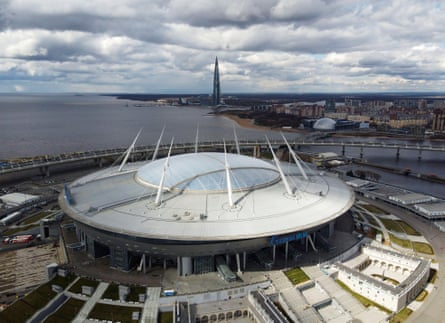
St Petersburg Stadium
Opened: 2017
Capacity: 61,000
Expected attendance: 30,500
Euro 2020 fixtures:
Belgium v Russia, 12 June
Poland v Slovakia, 14 June
Finland v Russia, 16 June
Sweden v Slovakia, 18 June
Finland v Belgium, 21 June
Sweden v Poland, 23 June
Quarter-final, 2 July
The home of Russian side Zenit St Petersburg, this stadium was the recipient of bonus group games relocated from Dublin after the Irish government were unable to provide assurances they would be able to welcome visiting fans. Built on the site of Zenit’s former Kirov Stadium at a cost of over a billion US dollars, it is believed to be the most expensive football stadium on the planet and was completed eight years late, coming in at a mind-boggling 548% over budget.


Overlooking the Gulf of Finland from its location on the western tip of Krestovsky Island, it was designed by Japanese architects Kisho Kurokawa, who intended it to look like a spaceship and describe the project as “a prestigious landmark stadium characterised by its symbolic masts suspending its gigantic flat roof”. One of the venues for the 2018 World Cup, it hosted the third-place play-off, which England lost to Belgium.
Located 9km from St Petersburg city centre, matchgoing fans are advised to leave for the stadium in plenty of time for kick-off: the nearest metro station to the ground is a mile away, and the temptation to take a ride on one of the several rollercoasters in the adjacent park may be too much for many to resist.

Stadium La Cartuja Sevilla
Opened: 1999
Capacity: 60,000
Expected attendance: 20,000
Euro 2020 fixtures:
Spain v Sweden, 14 June
Spain v Poland, 19 June
Slovakia v Spain, 23 June
Round of 16, 27 June
A late replacement for San Mamés, the home of Athletic Bilbao, which was unable to guarantee a minimum capacity of 25% due to the slow rollout of Covid vaccinations in the Basque Country, the Estadio La Cartuja is one of three major stadiums in Seville, although neither of the city’s La Liga teams, Sevilla and Real Betis, call it home.
Overlooking the Guadalquivir river from its location on the city’s Isla de la Cartuja (Island of the Carthusians), it was originally built to host the 1999 World Athletics Championships and was the centrepiece for Seville’s unsuccessful bids for the 2004 and 2008 Olympics.
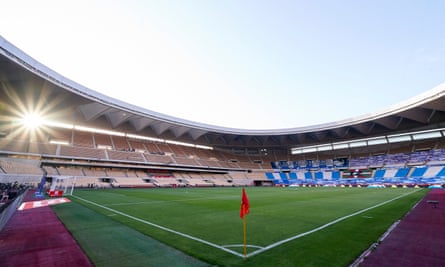
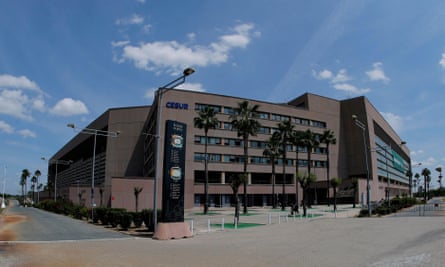
Although regarded locally as something of a white elephant, in its time La Cartuja has hosted the 2003 Uefa Cup final between Porto and Celtic, the past two Copa del Rey finals and several of Spain’s international matches. However, the presence of an athletics track means sightlines from the stands are poor, making it far from an ideal arena for football, despite its standing as Spain’s third-largest stadium.
It will host four matches during the Euros but is likely to prove the tournament’s least atmospheric and least popular venue despite the presence of 20,000 fans per game.
